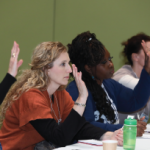“Psychologists aim to identify and address psychosocial factors that can worsen pain severity and daily functioning, such as chronic stress or trauma, social anxiety and depression,” Dr. Rosales says. “It is important to recognize that the coordination of these disciplines is key to treatment success.”
Successful Collaboration
Care conferences are one important collaborative strategy Dr. Kim, Dr. Rosales and their team members apply to treat pediatric pain through this model. A care conference provides a way for all team members to come together and openly discuss a patient’s progress, areas of improvement and concerns. This meeting helps create an individualized program plan for the patient that will set them up for success, Dr. Rosales notes.
“Take a patient who reports no discomfort to a physical therapist because they may fear they are perceived as weak or non-compliant. But [that patient] may then report to the physician or psychologist that they are in fact experiencing pain. Similarly, the physical therapist may see that the patient is struggling in a particular area that may prompt different management by the physician or psychologist,” she says.
Carina Stanton is a freelance science journalist based in Denver.
References
- Gatchel RJ, Howard KJ. The biopsychosocial approach. Practical Pain Management. 2018 Apr;8(4).
- Schanberg LE, Anthony KK, Gil KM, et al. Daily pain and symptoms in children with polyarticular arthritis. Arthritis Rheum. 2003 May;48(5):1390–1397.
Learn More
Eugene Kim, MD, Alvina Rosales, PhD, and occupational therapist Talitha Cox are sharing their perspectives on the interdisciplinary roles of the physician, psychologist and occupational therapist in applying the bio-psycho-social model for pain management during the 2019 ACR/ARP Annual Meeting, Nov. 8–13.


